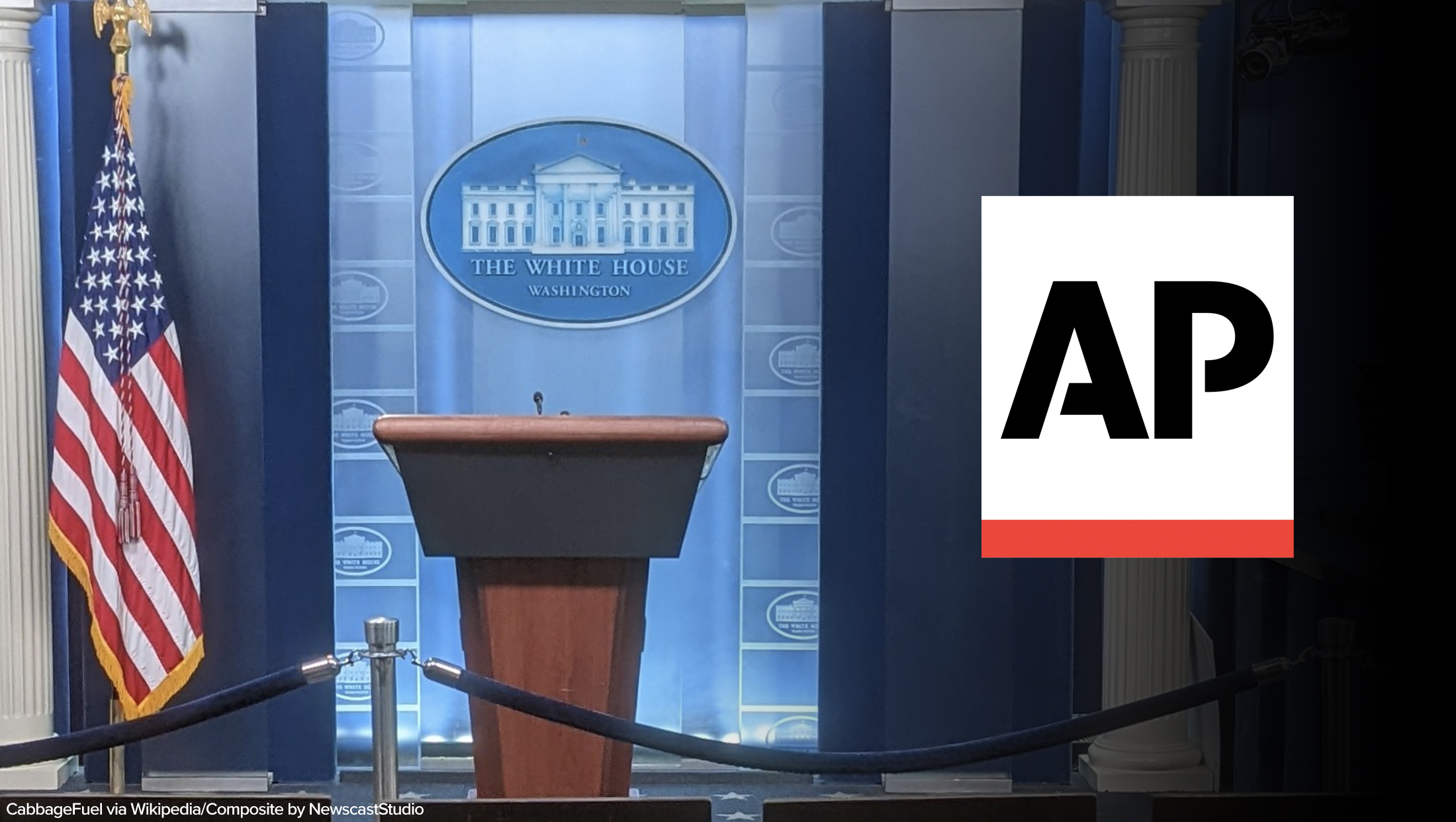White House excludes AP from events over its style guidance for ‘Gulf of Mexico’

Subscribe to NCS for the latest news, project case studies and product announcements in broadcast technology, creative design and engineering delivered to your inbox.
Update: This story has been updated with further developments.
The White House barred an Associated Press reporter from multiple events, including Oval Office ones, over style guidelines for the Gulf of Mexico — and has now indicated a willingness to continue to do so.
While neither the reporter nor the AP’s general press credentials were affected so far, the organization was barred from a specific Oval Office event that was otherwise open to other members of the media.
On Jan. 23, 2025, the Associated Press published an announcement on its website and digital style products indicating that its style guidelines for the Gulf of Mexico were being tweaked after Donald Trump ordered the body of water be renamed the “Gulf of America.” This followed Trump’s controversial executive order declaring “Gulf of America” as the new name.
“The Associated Press will refer to it by its original name while acknowledging the new name Trump has chosen,” reads the post.
In the same post, the AP did indicate it would update its style to revert back to calling North America’s highest peak Mount McKinley. President Barack Obama changed the name of the mountain to Denali in 2015, reflecting the traditional native Alaskan name for it.
The mountain’s “McKinley” name goes back to 1896, when a gold prospector created the name to show support for William McKinley, who was running for president as a post-Civil War Republican at the time — and would later win. McKinley never visited Alaska.
The AP noted that Trump, like Obama, does have legal authority to change the names of certain geographic features within U.S. borders. The agency similarly followed Obama’s order in its official style.
On Feb. 14, 2025, the White House indicated that it would continue to “limit” the AP’s access to the Oval Office and Air Force One until it changes its style.
“The Associated Press continues to ignore the lawful geographic name change of the Gulf of America,” deputy chief of staff Taylor Budowich wrote on X (executive orders do not carry the force of law and it is debatable whether any president can rename a body of water that lies outside of the country other than, perhaps, a few miles offshore).
“This decision is not just divisive, but it also exposes the Associated Press’ commitment to misinformation. While their right to irresponsible and dishonest reporting is protected by the First Amendment, it does not ensure their privilege of unfettered access to limited spaces, like the Oval Office and Air Force One,” Budowich continued.
There is no evidence that the Associated Press publishes misinformation or is dishonest in its reportage, let alone having a “commitment” to do so. The AP is also has a solid record of accurate and responsible reporting and is regularly ranked as one of the most trusted news organizations in the U.S. unlike outlets such as FNC, Newsmax, OAN and The Daily Caller.
In the case of the “Gulf of America,” the AP wrote:
“Trump’s order only carries authority within the United States. Mexico, as well as other countries and international bodies, do not have to recognize the name change.”
This, in part, led to its decision to not use the “Gulf of America” name in most references to the body of water.
“It is alarming that the Trump administration would punish AP for its independent journalism,” said AP’s Senior Vice President and Executive Editor Julie Pace said in a statement. “Limiting our access to the Oval Office based on the content of AP’s speech not only severely impedes the public’s access to independent news, it plainly violates the First Amendment.”
Julie Pace, senior vice president and executive editor of The Associated Press, called the administration’s move unacceptable.
The AP reported that White House officials specifically informed it that the barring of its journalist was directly linked to its style decision.
The AP later indicated that it stands by its decision.
Proponents of the gulf name change have argued, incorrectly, that since the U.S. has more coastline touching the body of water in question Trump’s name is valid. However, although exact figures vary, most reputable sources indicate Mexico has slightly more of its coastline touching the water (no matter which measurement is used, there is no internationally-recognized standard that indicates this should guide or rule naming conventions).
One reason for the discrepancies in measures is likely due to how the intricate twists and turns of the coast is measured and what, exactly, one considers the “border” of the gulf. Mexico’s coastline calculation can also include some small portions of Cuba that it owns.
Meanwhile, the AP notes that the Gulf of Mexico name has been used for more than 400 years (again, this isn’t necessarily an absolute approach for determining naming) and that one of the stated goals of its use of consistent style is ensure that people from “all audiences” are still able to recognize what a story or article might be referring to.
“The AP regularly reviews its style guidance regarding name changes, in part to ensure its guidance reflects common usage. We’ll continue to apply that approach to this guidance and make updates as needed,” the announcement says.
Outside of the AP’s justification, many countries, including the U.S., recognize that “territorial sea” only reaches 12 nautical miles (about 13.8 standard miles) into an international body of water. This concept is recognized by the United Nations.
There is also a concept known as the “exclusive economic zone,” which is used, in part, to dictate what country has rights to use any natural resources found off its cost. This is measured at 200 nautical miles (230 miles) but is not necessarily a standard for measuring geographic claims to the area a body of water.
The Gulf of Mexico also has a “maritime” border that runs roughly along the 26th parallel with two “gaps” along the way. It also indicates that part of the gulf is under Cuba’s maritime border. This was created by a treaty between the U.S. and Mexico in the 1970s. However, using the metric of total area, Mexico’s portion of the gulf under this approach is still larger than the U.S. or Cuba.
In cases where clarification is needed to differentiate between the names of both the gulf and mountain in question, the label “federal designation” could be helpful in many cases because this notes, correctly, the the federal government is, via Trump’s orders, designating a certain name for something but that it might not be recognized outside of the U.S.
Associated Press style is used by hundreds of news organizations in the U.S. and even more around the word. Local newsrooms can and do often override AP style in certain cases, typically in cases where local residents are more accustomed to a different format. The style is also not legally enforceable and the AP cannot directly force its members to use all of its style guidelines across the board.
Like most style guides, AP style is meant to help ensure that usage and conventions are consistent no matter who writes them. Because the AP picks up stories, often only lightly edited, from member news outlets around the world, having base guidelines for aspects such as how states are abbreviated and what names are used to refer to geographic features, helps keep stories from needing more heavy line editing when used by other members.
Portions of AP style also were originally linked to limitations about what characters could be transmitted over the literal wires (in the sense of teletype machines) the AP originally used. For example, symbols such as the “%” symbol were not compatible with all equipment at one point, so AP guidelines called for figures to be spelled out: “70 percent” instead of “70%.” This style was changed, however, after the transmission limitations were no longer a concern. AP Style was also driven by a desire to standardize certain abbreviations in order to save space in printed publications and transmission costs.
Subscribe to NCS for the latest news, project case studies and product announcements in broadcast technology, creative design and engineering delivered to your inbox.





tags
Associated Press, donald trump, Donald Trump Second Term, white house, White House Press Corps
categories
Broadcast Industry News, Featured, Journalism